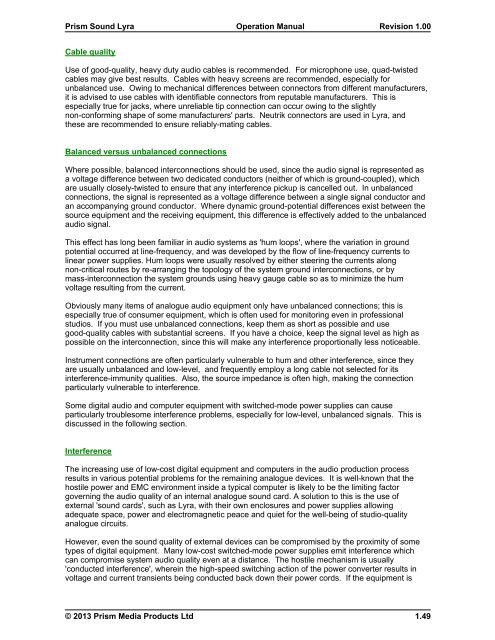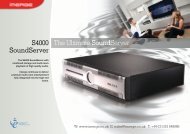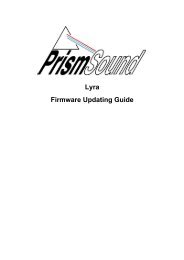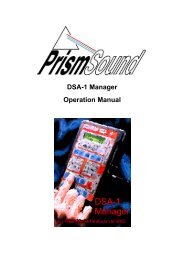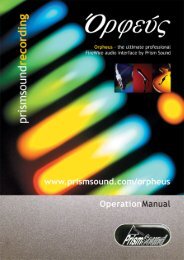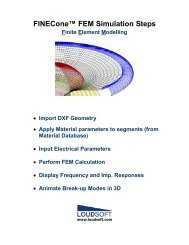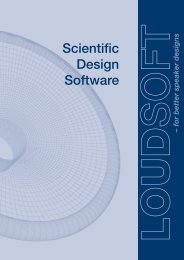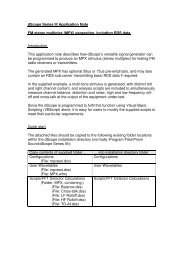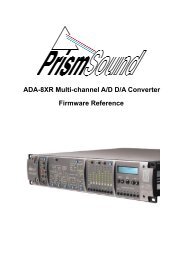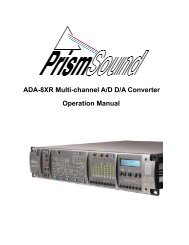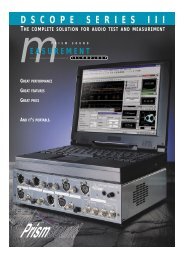Lyra Operation Manual - Test and Measurement - Prism Sound
Lyra Operation Manual - Test and Measurement - Prism Sound
Lyra Operation Manual - Test and Measurement - Prism Sound
- No tags were found...
Create successful ePaper yourself
Turn your PDF publications into a flip-book with our unique Google optimized e-Paper software.
<strong>Prism</strong> <strong>Sound</strong> <strong>Lyra</strong><strong>Operation</strong> <strong>Manual</strong>Revision 1.00Cable qualityUse of good-quality, heavy duty audio cables is recommended. For microphone use, quad-twistedcables may give best results. Cables with heavy screens are recommended, especially forunbalanced use. Owing to mechanical differences between connectors from different manufacturers,it is advised to use cables with identifiable connectors from reputable manufacturers. This isespecially true for jacks, where unreliable tip connection can occur owing to the slightlynon-conforming shape of some manufacturers' parts. Neutrik connectors are used in <strong>Lyra</strong>, <strong>and</strong>these are recommended to ensure reliably-mating cables.Balanced versus unbalanced connectionsWhere possible, balanced interconnections should be used, since the audio signal is represented asa voltage difference between two dedicated conductors (neither of which is ground-coupled), whichare usually closely-twisted to ensure that any interference pickup is cancelled out. In unbalancedconnections, the signal is represented as a voltage difference between a single signal conductor <strong>and</strong>an accompanying ground conductor. Where dynamic ground-potential differences exist between thesource equipment <strong>and</strong> the receiving equipment, this difference is effectively added to the unbalancedaudio signal.This effect has long been familiar in audio systems as 'hum loops', where the variation in groundpotential occurred at line-frequency, <strong>and</strong> was developed by the flow of line-frequency currents tolinear power supplies. Hum loops were usually resolved by either steering the currents alongnon-critical routes by re-arranging the topology of the system ground interconnections, or bymass-interconnection the system grounds using heavy gauge cable so as to minimize the humvoltage resulting from the current.Obviously many items of analogue audio equipment only have unbalanced connections; this isespecially true of consumer equipment, which is often used for monitoring even in professionalstudios. If you must use unbalanced connections, keep them as short as possible <strong>and</strong> usegood-quality cables with substantial screens. If you have a choice, keep the signal level as high aspossible on the interconnection, since this will make any interference proportionally less noticeable.Instrument connections are often particularly vulnerable to hum <strong>and</strong> other interference, since theyare usually unbalanced <strong>and</strong> low-level, <strong>and</strong> frequently employ a long cable not selected for itsinterference-immunity qualities. Also, the source impedance is often high, making the connectionparticularly vulnerable to interference.Some digital audio <strong>and</strong> computer equipment with switched-mode power supplies can causeparticularly troublesome interference problems, especially for low-level, unbalanced signals. This isdiscussed in the following section.InterferenceThe increasing use of low-cost digital equipment <strong>and</strong> computers in the audio production processresults in various potential problems for the remaining analogue devices. It is well-known that thehostile power <strong>and</strong> EMC environment inside a typical computer is likely to be the limiting factorgoverning the audio quality of an internal analogue sound card. A solution to this is the use ofexternal 'sound cards', such as <strong>Lyra</strong>, with their own enclosures <strong>and</strong> power supplies allowingadequate space, power <strong>and</strong> electromagnetic peace <strong>and</strong> quiet for the well-being of studio-qualityanalogue circuits.However, even the sound quality of external devices can be compromised by the proximity of sometypes of digital equipment. Many low-cost switched-mode power supplies emit interference whichcan compromise system audio quality even at a distance. The hostile mechanism is usually'conducted interference', wherein the high-speed switching action of the power converter results involtage <strong>and</strong> current transients being conducted back down their power cords. If the equipment is© 2013 <strong>Prism</strong> Media Products Ltd1.49


